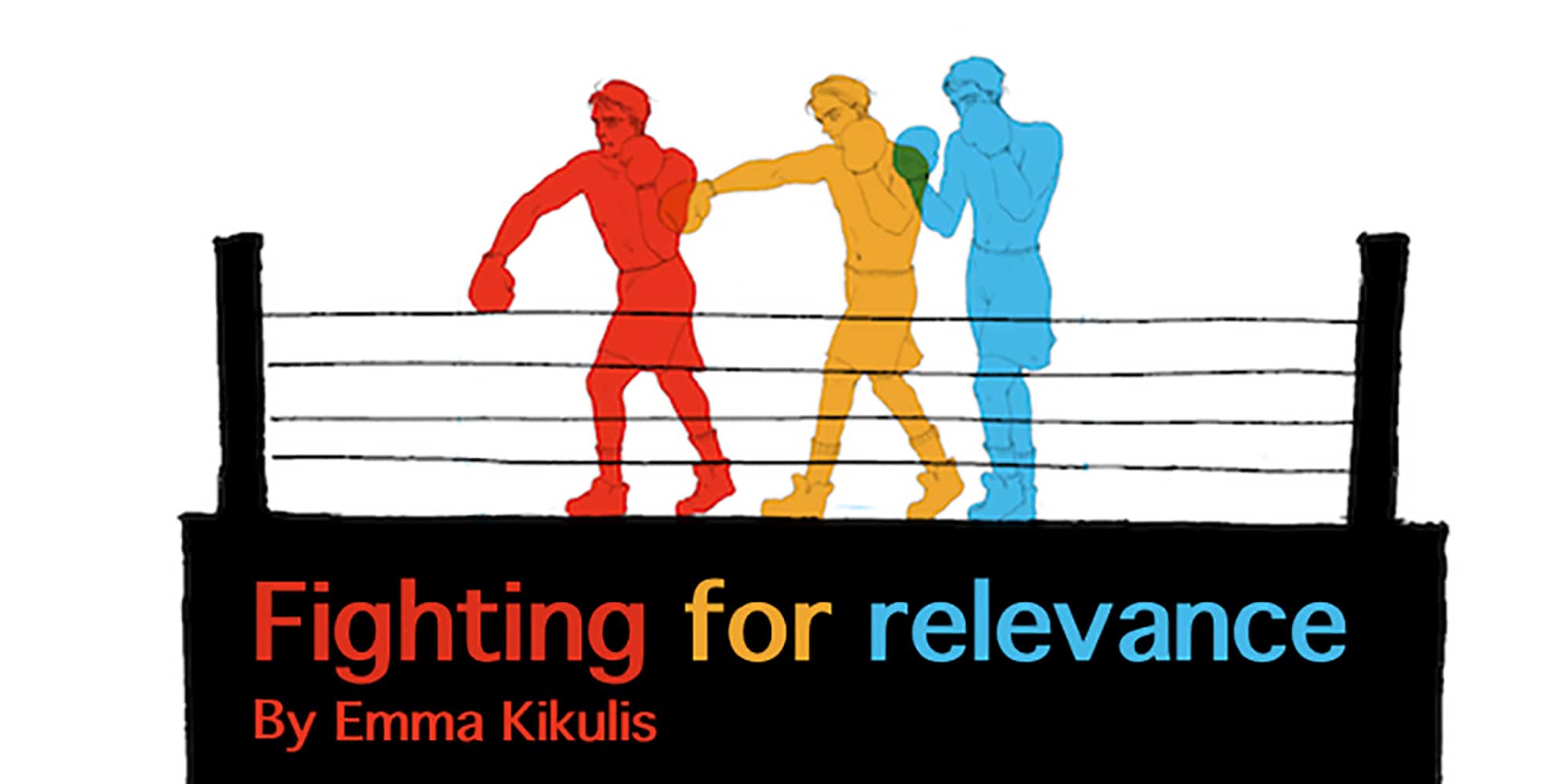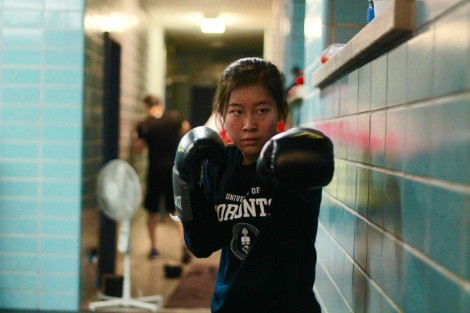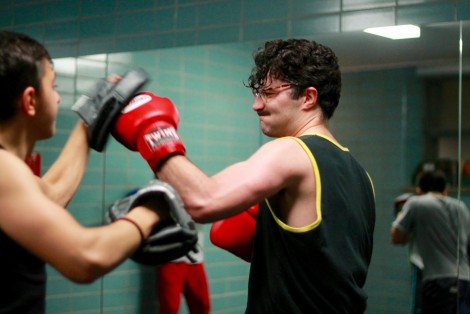[dropcap]T[/dropcap]HE WELLNESS CENTRE, where the U of T boxing club trains, is cozy to say the least. No bigger than the average classroom and hitting full capacity at just 11 occupants, the room doesn’t feel like it should be able to accommodate a bunch of energetic student boxers. After observing one of the club’s classes last semester, however, I feel as though the space — small as it may be — serves its purpose.
Situated at the back of Elmsley Hall at St. Michael’s College, the Wellness Centre is the quintessential student boxer’s locale. The dimly lit room feels like a hole in the wall. The space is grungy, out of the way, and slightly intimidating, which come together to create a back-alley Fight Club vibe.
[pullquote-yale]The dimly lit room feels like a hole in the wall. The space is grungy, out of the way, and slightly intimidating, which come together to create a back-alley Fight Club vibe.[/pullquote-yale]
The boxing club turns out to be anything but intimidating. As I stand in the corner of the room getting my hand professionally wrapped by club president Koya Kuse, I watch a group of five students going about their warm up exercises; their routines are punctuated by laughter, joking from coaches, and frequent requests for music changes — there are no Tyler Durdens here.
Sports and Arts
Kuse has been boxing for most of his adult life. He credits his mother with introducing him to the sport; the two often trained together when he was living at home in Paris, France. He maintains that he is not a professional and enjoys the recreational aspect of boxing.
The love of the sport is what prompted Kuse, upon entering university, to look for a club to continue his training. “So it all started last year. I was looking for a boxing club but couldn’t find any at U of T, so I talked about boxing with a couple of friends, some of them box, some of them don’t,” he says. “They told me that I could maybe create a club to train and maybe train other people as well, at least have something for us.” After rallying a group of residence mates and frosh week friends, Kuse helped inaugurate U of T’s boxing club.
Twenty-five years ago, there may not have been a need to create a club, as the university already had a varsity boxing team at that time. Established in the 1940s, U of T’s varsity boxing team was headed by Anthony Canzano, who coached the program for a total of 37 years — longer than any other varsity coach to date. Boxing was de-listed as an OUA and intercollegiate sport in the late 1980s though, marking the end of U of T’s varsity boxing team.
Kuse’s interest in boxing parallels a global spike in popularity of combat sports — including mixed martial arts (MMA) and Muay Thai — for health and fitness purposes. These activities have been both lauded and criticized for their extreme physicality.
Despite the rise in the popularity of these activities, the terms martial arts and combat sports are often confused. Definitions vary significantly depending on the perspective of the person using the term and the activity they are describing. Judo, taekwondo, and karate are widely considered martial arts, whereas MMA and Muay Thai are considered combat sports.
Boxing, on the other hand, oten straddles both categories. Some argue that boxing is a martial art because of the precision and grace required in the ring. Others claim that any activity with rules and a set of referees or judges cannot truly be considered a martial art — therefore placing boxing into the combat sport category.
For Remi Pulwer, head of public services at Kelly Library and martial artist, boxing falls into the latter category. “When you have a judge and someone who is controlling the match, that’s a sport, so in this case boxing would be a sport. However, taking into consideration the brutality of the outcome, sometimes this is on the verge of a martial art and martial sport in my mind,” he says.
Pulwer began his athletic career in fencing before moving through other multiple sports and martial arts. He finally settled on Taijutsu, one of the oldest forms of Japanese martial arts and the progenitor of multiple disciplines, like judo and aikido. Pulwer cautions that Taijutsu is not for the faint of heart. “This is a battle field form, so it’s a combat art, it’s not a sport in any way,” he explains.
Looking to continue practicing his craft, Pulwer and a number of students also interested in Taijutsu began the journey that led to the development of the Wellness Centre — a process that didn’t come easy.
Struggling for space
Five years ago, Pulwer started looking for a space to train at St. Michael’s College, eventually settling on a vacant space on the fifth floor of John Kelly Library.
After training there for a little while, the room was soon reclaimed. “Of course since space is such a commodity, we were moved out from that space so we moved to a different floor in the library and so on,” says Pulwer. This pattern of finding a space, using it for a while, and being relocated would continue for some time.
Last year, the group stumbled upon a hidden gem in the basement of Elmsley Hall. The space was cluttered with junk and was previously used as a hockey training facility, during the early days of the residence’s construction; it had all but been forgotten. “They have the change rooms, showers, there was a hallway, there was training space, there was a room for theory for the media, there was a whole complex inside, and we discovered it by removing garbage, and the showers were still operational, so it was quite a new discovery,” says Pulwer.
The Taijutsu group, which had now grown to include many students, staff, and volunteers, claimed the space and used it for more than just martial arts activities. They soon began to incorporate classes teaching self-defence, MMA, and yoga.
Despite the increased popularity of the classes and the suitability of the space, Pulwer and his gang of vagabond martial artists had to, yet again, move on. The facility ceased to be available to the group due to the demand for space at the college. “We were of course always given the other space, but eventually [every] single other space [became] claimed,” says Pulwer.
With the help of the facilities department at St. Mike’s, the group ended up relocating to their current location in Elmsley Hall, the final home of the Wellness Centre. Around the same time, Kuse and the boxing club were also looking for a space to hold classes — something that Kuse expected would be relatively easy after his simple registration.
After considering several other facilities on campus, the club reached out to Pulwer, who had transformed his space at Elmsley into a makeshift dojo, with the help of his martial arts group and volunteers “It was a concrete floor with walls and… a lot of junk,” says Pulwer about the state of the space before the group fixed it up. With their help, the facility became something new. “I actually came up with that name [the Wellness Centre] later on, when more people became interested in teaching instead of just martial arts,” he says.
Despite the centre’s limitations, the boxing club is persevering, and the group participants have learned to work around the spatial constrictions. “It is very difficult, but it’s nice,” says Kuse. “Regarding the training, it’s almost private lessons. Nine students plus two coaches, so only 11 people… it’s four or five students for each coach during two hours, so that’s very nice.”
With almost 600 members on the group’s Facebook page, 150 club members, and a waitlist of 130 students, the boxing club had to be creative in the scheduling of classes. Kuse explains how they fit in seven sessions a week, but only being able to offer nine spots per session still does not accommodate all of the boxing club’s members.
The club is weighing their options and would ideally like to train both at St. Mike’s and at larger facilities on campus. “Maybe one more fitness-oriented boxing class could happen at Hart House while something… more boxing-emphasized could happen at St. Michael’s,” says Kuse, on the best case scenario for the club going forward next year.
Teaming up
For Pulwer, allowing the club to train at the Wellness Centre required no deliberation. “It was up to me so I was like, ‘Why not?’” he says. He still insisted upon observing the classes and meeting with the executives and coaches to assess their coaching styles, in order to ensure they were to providing a safe environment.
“I’ve [spent] the last 25 years of my life in combat sports and combat arts, and I don’t think the proper instruction in this kind of form of exercise cannot be including sparring. It has to have sparring and I’m not really that much concerned, if the people they have proper instruction they will not be injured,” explains Pulwer. “It seems to be a really nice group of people, and really enthusiastic, and they work really hard.”
Both Kuse and Pulwer have made the Wellness Centre work to suit the needs of their members. In the class I attended, Kuse and fellow boxing club coach Tofik ‘Toto’ Haciyev took students through a series of defensive manoeuvres, moving athletes around the room to maximize all the space they could.
“[Martial arts are] really beneficial for students, especially university students who face so much stress… you know at the mental level, the physicality of martial arts is truly beneficial,” says Pulwer. He believes that student identities can be restricted to their study; activities like martial arts and combat sports are therefore important to the maintenance of well-rounded lives.
The Wellness Centre has been able to increase the presence of martial arts on campus and is fostering a fast-growing combat sports community for St. George students. Pulwer notes — and history has proven — that the threat of eviction from the space still looms large. “[W]e still live under this threat of disappearing,” says Pulwer. “So we’re trying to make sure that you know the space is thought of as a wellness studio centre, so it’s constantly in people’s mind… I have a feeling, if we stop and we disappear… then the space is going to be looked at as a space again.”
Regardless of the precariousness of their situation, the boxing club is looking to expand and has even created a space in the Wellness Centre where they hung heavy and speed bags — staples in any boxing gym.
Determined to make the club a success, Kuse is excited to continue developing the club and increase awareness of boxing. “We are trying to help students relieve stress and on top of that it’s a fun sport.”





